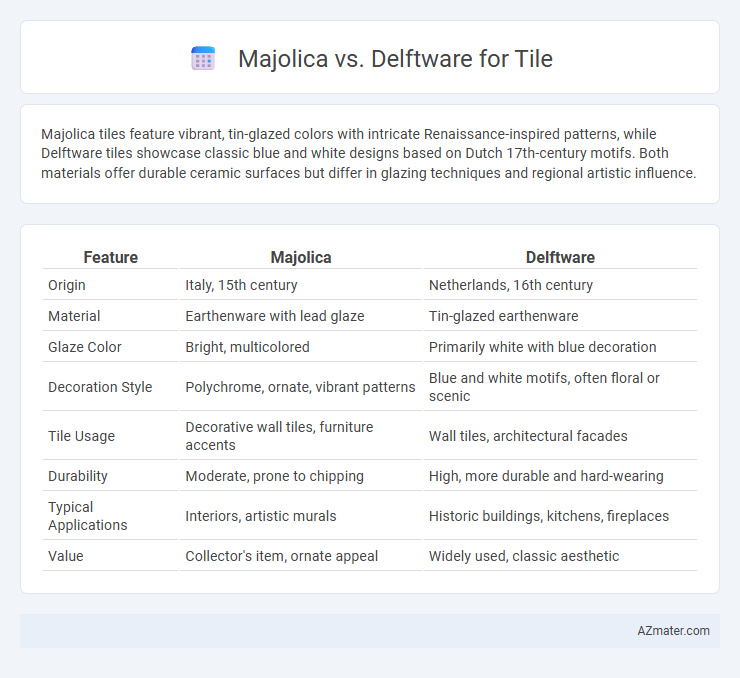Majolica tiles feature vibrant, tin-glazed colors with intricate Renaissance-inspired patterns, while Delftware tiles showcase classic blue and white designs based on Dutch 17th-century motifs. Both materials offer durable ceramic surfaces but differ in glazing techniques and regional artistic influence.
Table of Comparison
| Feature | Majolica | Delftware |
|---|---|---|
| Origin | Italy, 15th century | Netherlands, 16th century |
| Material | Earthenware with lead glaze | Tin-glazed earthenware |
| Glaze Color | Bright, multicolored | Primarily white with blue decoration |
| Decoration Style | Polychrome, ornate, vibrant patterns | Blue and white motifs, often floral or scenic |
| Tile Usage | Decorative wall tiles, furniture accents | Wall tiles, architectural facades |
| Durability | Moderate, prone to chipping | High, more durable and hard-wearing |
| Typical Applications | Interiors, artistic murals | Historic buildings, kitchens, fireplaces |
| Value | Collector's item, ornate appeal | Widely used, classic aesthetic |
Introduction to Majolica and Delftware Tiles
Majolica tiles feature vibrant, tin-glazed earthenware with intricate, hand-painted designs originating from Renaissance Italy, prized for their durable, glossy finish and rich color palette. Delftware tiles, developed in the Netherlands during the 16th century, showcase distinctive blue and white tin-glazed pottery inspired by Chinese porcelain, recognized for their detailed scenes and traditional motifs. Both styles offer unique aesthetic and historical value, with majolica emphasizing bold, multicolored artistry and Delftware highlighting classic, monochromatic elegance in tile design.
Historical Origins of Majolica and Delftware
Majolica originated during the Italian Renaissance in the 15th century, characterized by its tin-glazed pottery with vibrant, opaque colors and intricate designs inspired by Mediterranean and classical motifs. Delftware emerged in the 16th century in the Netherlands, influenced by Chinese porcelain and known for its blue and white tin-glazed earthenware decorated with floral and scenic patterns. Both ceramics share tin-glaze techniques but differ in cultural influences and artistic styles that reflect their distinct historical origins.
Key Differences in Production Techniques
Majolica tiles are created using a tin-glaze technique that involves applying an opaque white glaze on earthenware before painting vibrant, colorful designs, resulting in a glossy, vivid finish. Delftware tiles employ a tin-glaze method as well but are distinguished by their characteristic blue and white motifs painted on a white background, often featuring cobalt oxide pigments fired at high temperatures. The production of Majolica emphasizes bright, multicolored decoration with a smooth, reflective surface, whereas Delftware focuses on monochromatic blue designs with finer brushwork and a matte or semi-gloss finish.
Distinctive Color Palettes and Visual Styles
Majolica tiles showcase vibrant, glossy glazes with rich blues, greens, yellows, and oranges, often featuring intricate floral and nature-inspired motifs reflecting Italian Renaissance artistry. Delftware tiles typically present a limited color palette dominated by cobalt blue on a white tin-glazed background, emphasizing delicate, hand-painted scenes such as pastoral landscapes and geometric patterns rooted in Dutch heritage. The contrasting color saturation and thematic elements define Majolica's bold, decorative appeal versus Delftware's refined, monochromatic elegance.
Common Motifs and Decorative Patterns
Majolica tiles often feature vibrant floral and nature-inspired motifs with intricate scrollwork and rich blues, greens, and yellows, reflecting Mediterranean and Spanish influences. Delftware tiles predominantly showcase iconic blue and white color schemes with Dutch scenes, windmills, and traditional Dutch floral patterns characterized by fine, delicate detailing. Both styles emphasize hand-painted decorative patterns, but Majolica leans toward bold, colorful designs while Delftware favors more subdued, monochromatic artistry.
Geographic Influence on Design Evolution
Majolica tiles originated in Italy, heavily influenced by Mediterranean aesthetics featuring vibrant colors and intricate, nature-inspired patterns reflecting Renaissance artistry. Delftware tiles emerged in the Netherlands, shaped by Dutch cultural heritage with cobalt blue and white motifs influenced by Chinese porcelain trade during the 17th century. Geographic location played a crucial role in the evolution of these tiles, intertwining local materials, trade routes, and artistic traditions to create distinct visual identities.
Durability and Functional Characteristics
Majolica tiles, made from tin-glazed earthenware, offer vibrant colors and a glossy finish but tend to be less durable and more prone to chipping compared to Delftware. Delftware, crafted from tin-glazed stoneware, exhibits enhanced strength and resistance to wear, making it more suitable for high-traffic areas and functional applications. Both types provide aesthetic appeal, but Delftware's denser body and firing process ensure superior longevity and practical durability for floor and wall tiles.
Applications in Modern and Traditional Interiors
Majolica tiles, known for their vibrant, hand-painted glazes, are ideal for creating eye-catching feature walls and backsplashes in both modern kitchens and traditional Mediterranean-inspired interiors. Delftware tiles, characterized by their iconic blue and white patterns, bring a classic European charm to fireplaces, bathrooms, and accent areas in vintage or cottage-style homes. Both styles offer durable, ceramic tile options that enhance aesthetic appeal while providing functional, easy-to-clean surfaces suitable for diverse interior design applications.
Collectibility and Market Value Considerations
Majolica tiles, known for their vibrant colors and intricate relief patterns, often appeal to collectors seeking ornate and historically rich pieces, commanding higher market values due to their artistic craftsmanship and rarity. Delftware tiles, characterized by their iconic blue and white hand-painted designs, attract collectors interested in classic European ceramics, typically offering more accessible prices but with stronger brand recognition and historical significance. Both types hold strong market value, but Majolica's uniqueness often leads to greater premium appreciation among specialized collectors and antique markets.
Choosing Between Majolica and Delftware for Your Project
Choosing between Majolica and Delftware for your tile project depends on the desired aesthetic and historical context. Majolica tiles feature vibrant, tin-glazed surfaces with bold, colorful patterns inspired by Italian Renaissance art, making them ideal for creating a lively and ornate look. Delftware tiles, originating from the Netherlands, showcase delicate blue and white designs with intricate floral or scenic motifs, perfect for adding a classic, refined touch to traditional or vintage-inspired spaces.

Infographic: Majolica vs Delftware for Tile
 azmater.com
azmater.com